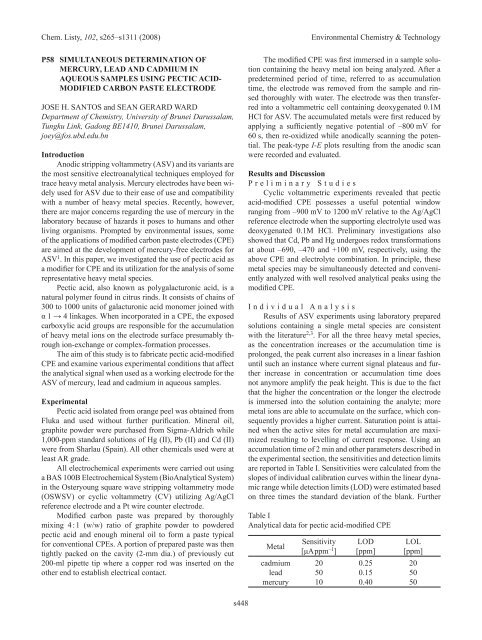2. ENVIRONMENTAL ChEMISTRy & TEChNOLOGy 2.1. Lectures
2. ENVIRONMENTAL ChEMISTRy & TEChNOLOGy 2.1. Lectures
2. ENVIRONMENTAL ChEMISTRy & TEChNOLOGy 2.1. Lectures
Create successful ePaper yourself
Turn your PDF publications into a flip-book with our unique Google optimized e-Paper software.
Chem. Listy, 102, s265–s1311 (2008) Environmental Chemistry & Technology<br />
P58 SIMuLTANEOuS DETERMINATION OF<br />
MERCuRy, LEAD AND CADMIuM IN<br />
AQuEOuS SAMPLES uSING PECTIC ACID-<br />
MODIFIED CARbON PASTE ELECTRODE<br />
JOSE H. SAnTOS and SEAn GERARD WARD<br />
Department of Chemistry, University of Brunei Darussalam,<br />
Tungku Link, Gadong BE1410, Brunei Darussalam,<br />
joey@fos.ubd.edu.bn<br />
Introduction<br />
Anodic stripping voltammetry (ASV) and its variants are<br />
the most sensitive electroanalytical techniques employed for<br />
trace heavy metal analysis. Mercury electrodes have been widely<br />
used for ASV due to their ease of use and compatibility<br />
with a number of heavy metal species. Recently, however,<br />
there are major concerns regarding the use of mercury in the<br />
laboratory because of hazards it poses to humans and other<br />
living organisms. Prompted by environmental issues, some<br />
of the applications of modified carbon paste electrodes (CPE)<br />
are aimed at the development of mercury-free electrodes for<br />
ASV 1 . In this paper, we investigated the use of pectic acid as<br />
a modifier for CPE and its utilization for the analysis of some<br />
representative heavy metal species.<br />
Pectic acid, also known as polygalacturonic acid, is a<br />
natural polymer found in citrus rinds. It consists of chains of<br />
300 to 1000 units of galacturonic acid monomer joined with<br />
α 1 → 4 linkages. When incorporated in a CPE, the exposed<br />
carboxylic acid groups are responsible for the accumulation<br />
of heavy metal ions on the electrode surface presumably through<br />
ion-exchange or complex-formation processes.<br />
The aim of this study is to fabricate pectic acid-modified<br />
CPE and examine various experimental conditions that affect<br />
the analytical signal when used as a working electrode for the<br />
ASV of mercury, lead and cadmium in aqueous samples.<br />
Experimental<br />
Pectic acid isolated from orange peel was obtained from<br />
Fluka and used without further purification. Mineral oil,<br />
graphite powder were purchased from Sigma-Aldrich while<br />
1,000-ppm standard solutions of Hg (II), Pb (II) and Cd (II)<br />
were from Sharlau (Spain). All other chemicals used were at<br />
least AR grade.<br />
All electrochemical experiments were carried out using<br />
a BAS 100B Electrochemical System (BioAnalytical System)<br />
in the Osteryoung square wave stripping voltammetry mode<br />
(OSWSV) or cyclic voltammetry (CV) utilizing Ag/AgCl<br />
reference electrode and a Pt wire counter electrode.<br />
Modified carbon paste was prepared by thoroughly<br />
mixing 4 : 1 (w/w) ratio of graphite powder to powdered<br />
pectic acid and enough mineral oil to form a paste typical<br />
for conventional CPEs. A portion of prepared paste was then<br />
tightly packed on the cavity (2-mm dia.) of previously cut<br />
200-ml pipette tip where a copper rod was inserted on the<br />
other end to establish electrical contact.<br />
s448<br />
The modified CPE was first immersed in a sample solution<br />
containing the heavy metal ion being analyzed. After a<br />
predetermined period of time, referred to as accumulation<br />
time, the electrode was removed from the sample and rinsed<br />
thoroughly with water. The electrode was then transferred<br />
into a voltammetric cell containing deoxygenated 0.1M<br />
HCl for ASV. The accumulated metals were first reduced by<br />
applying a sufficiently negative potential of –800 mV for<br />
60 s, then re-oxidized while anodically scanning the potential.<br />
The peak-type I-E plots resulting from the anodic scan<br />
were recorded and evaluated.<br />
Results and Discussion<br />
P r e l i m i n a r y S t u d i e s<br />
Cyclic voltammetric experiments revealed that pectic<br />
acid-modified CPE possesses a useful potential window<br />
ranging from –900 mV to 1200 mV relative to the Ag/AgCl<br />
reference electrode when the supporting electrolyte used was<br />
deoxygenated 0.1M HCl. Preliminary investigations also<br />
showed that Cd, Pb and Hg undergoes redox transformations<br />
at about –690, –470 and +100 mV, respectively, using the<br />
above CPE and electrolyte combination. In principle, these<br />
metal species may be simultaneously detected and conveniently<br />
analyzed with well resolved analytical peaks using the<br />
modified CPE.<br />
I n d i v i d u a l A n a l y s i s<br />
Results of ASV experiments using laboratory prepared<br />
solutions containing a single metal species are consistent<br />
with the literature 2,3 . For all the three heavy metal species,<br />
as the concentration increases or the accumulation time is<br />
prolonged, the peak current also increases in a linear fashion<br />
until such an instance where current signal plateaus and further<br />
increase in concentration or accumulation time does<br />
not anymore amplify the peak height. This is due to the fact<br />
that the higher the concentration or the longer the electrode<br />
is immersed into the solution containing the analyte; more<br />
metal ions are able to accumulate on the surface, which consequently<br />
provides a higher current. Saturation point is attained<br />
when the active sites for metal accumulation are maximized<br />
resulting to levelling of current response. Using an<br />
accumulation time of 2 min and other parameters described in<br />
the experimental section, the sensitivities and detection limits<br />
are reported in Table I. Sensitivities were calculated from the<br />
slopes of individual calibration curves within the linear dynamic<br />
range while detection limits (LOD) were estimated based<br />
on three times the standard deviation of the blank. Further<br />
Table I<br />
Analytical data for pectic acid-modified CPE<br />
Metal<br />
Sensitivity LOD LOL<br />
[μA ppm –1 ] [ppm] [ppm]<br />
cadmium 20 0.25 20<br />
lead 50 0.15 50<br />
mercury 10 0.40 50

















